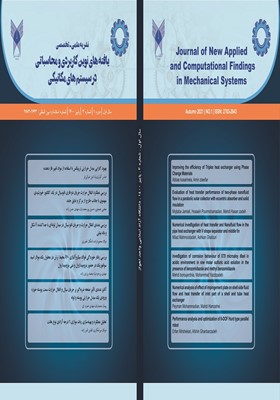تحلیل عملکرد و بهینهسازی ربات موازی 6 درجه آزادی نوع هانت
محورهای موضوعی : یافته های نوین کاربردی و محاسباتی در سیستم های مکانیکیعرفان میرشکاری 1 * , افشین قنبرزاده 2
1 - گروه مهندسی مکانیک، دانشگاه آزاد اسلامی واحد اهواز
2 - گروه مهندسی مکانیک، دانشکده مهندسی، دانشگاه شهید چمران اهواز، ایران
کلید واژه: نمودار پارتو, شاخص های عملکردی, ربات موازی نوع هانت, بهینه سازی چندهدفه,
چکیده مقاله :
در کار حاضر، ربات موازی شش درجه آزادی با محرک دورانی نوع هانت بر اساس شاخصهای عملکردی سینماتیکی-استاتیکی بهینه میگردد و تاثیر پارامترهای هندسی ساختاری بر این شاخصها مورد بررسی قرار میگیرد. بدین منظور، ابتدا ویژگی های ساختاری و هندسی ربات موازی شش درجه آزادی با محرک دورانی نوع هانت معرفی میگردند. سپس روابط مربوط به سینماتیک معکوس برای تعیین ارتباط میان مختصات مفصلی ربات و مجری نهایی استخراج میشود. ماتریس ژاکوبین به عنوان ارتباطدهنده بردار سرعت مجری نهایی و بردار سرعت های زاویهای مفصلی استخراج می-گردد. شاخصهای توانایی تردستی، ظرفیت اعمال نیرو و عدد وضعیت به عنوان شاخصهای عملکردی مد نظر قرار میگیرند. پس از تعیین تابع هدف، قیود بهینهسازی و حدود پارامترهای هندسی با استفاده از روش بهینهسازی زنبور عسل چند هدفه، نمودار پارتو مربوط به پاسخهای نامغلوب که نشان دهنده توزیع بهترین پاسخها است به دست میآیند. در نهایت، ساختارهایی ارائه میشود که هرکدام از آنها بر مبنای یکی از شاخصهای عملکرد دارای بهتزین عملکرد میباشد. همچنین از میان دسته مشخصات هندسی به دست آمده از نمودار پارتو، یک ساختار انتخاب میگردد از لحاظ هر سه مشخصه عملکردی، وضعیت مناسبی دارد. در نهایت تاثیر تغییر مکان مجری نهایی در فضای کاری بر عملکرد ربات موازی نوع هانت مورد بررسی قرار میگیرد.
In this research, Hunt type 6-DOF parallel robot is optimized based on kinetostatic performance indices and the effect of geometrical parameters on these indices is investigated. For this purpose, structural and geometrical parameters of Hunt type parallel robot are introduced. in order to determine the relationship between joint angle values and end effector coordinates, inverse kinematic is obtained. Jacobian matrix is developed to map velocity from joint space to Cartesian space. Manipulability, force manipulability and condition number are considered as indices to evaluate the robot performance. By defining the fitness functions, constraints and boundaries of geometric parameters, the optimized parallel robot structure is obtained using the multi-objective bees algorithm. A set of robot geometric parameters is presented, each of which has the best performance based on one of the indices. Also, a robot with specific geometric parameters is selected, which is suitable based on almost all performance indices. Finally, the effect of end effector movement on robot performance is investigated.
[1] Li, J., Zuo, S., Zhang, L., Dong, M., Zhang, Z., Tao, C., and Ji, R., (2020), Mechanical design
and performance analysis of a novel parallel robot for ankle rehabilitation, Journal of
Mechanisms and Robotics, 12)5(, pp 051007.
[2] Salisbury, J. K. and Graig, J. J., (1982), Articulated hands:force control and kinematic issues,
he International Journal of Robotics Research,1, pp 4-17.
[3] Angeles, J. and Ma, O., (1988), Dynamic simulation of n-axis serial robotic manipulators
using a natural orthogonal complement, The International Journal of Robotics Research,7(5),
pp 32-47.
[4] Gosselin, C., "kinematic analysis, optimization and programming of parallel robotic
manipulators," Phd, mechanical Engineering, McGill University, Montreal, 1988.
[5] Yoshikawa, T., (1985), Manipulability of Robotic Mechanisms, The International Journal of
Robotics Research, 4, pp 3-9.
[6] Khan, W. A. and Angeles, J., (2006), The Kinetostatic Optimization of Robotic Manipulators:
The Inverse and the Direct Problems, Journal of Mechanical Design, 128, pp 168–178.
[7] Lara-Molina, F. A. and Dumur, D., (2021), Robust multi-objective optimization of parallel
manipulators, Meccanica, 56(11), pp 2843-2860.
[8] Nabavi, S. N., Shariatee, M., Enferadi, J., and Akbarzadeh, A., (2020), Parametric design and
multi-objective optimization of a general 6-PUS parallel manipulator, Mechanism and
Machine Theory,152, pp 103913.
[9] Zarkandi, S., (2021), Kinematic analysis and workspace optimization of a novel 4R P SP+ PS
parallel manipulator, Mechanics Based Design of Structures and Machines, 49,(1), ppp 131-
153.
[10] Mirshekari, E., Ghanbarzadeh, A., and Shirazi, K. H., (2016), Structure comparison and
optimal design of 6-RUS parallel manipulator based on kinematic and dynamic performances,
Latin American Journal of Solids and Structures,13, pp 2414-2438.
[11] Hunt, K., (1983), Structural kinematics of in-parallel-actuated robot-arms, Journal of
mechanisms, transmissions and automation in design,105(4), pp 705-712.
[12] Gil, J., Zabalza, I., Ros, J., Pintor, J., and Jiménez, J., "Kinematics and Dynamics of a 6-RUS
Hunt-Type Parallel Manipulator by Using Natural Coordinates," in On Advances in Robot
Kinematics: Springer, 2004, pp 329-335.
[13] Aginaga, J., Zabalza, I., Altuzarra, O., and jera, J., (2012), Improving static stiffness of the 6-
RUS parallel manipulator using inverse singularities Robotics and Computer-Integrated
Manufacturing,28, pp. 451-479.
[14] Pierrot, F., (1990), A new design of a 6-DOF parallel robot, J. of Robotics and Mechatronics,
2(4), pp 308-315.
[15] Pham, D. T. and Ghanbarzadeh, A., "Multi-Objective Optimisation using the Bees
Algorithm," presented at the 3rd International Virtual Conference on Intelligent Production
Machines and Systems (IPROMS 2007), Whittles, Dunbeath, Scotland, 2007.
[16] Gosselin, C. and Angeles, J., (1990), Singularity analysis of closed-loop kinematic chains,
IEEE Trans. Robot. Automat.,6, pp 281-291.

